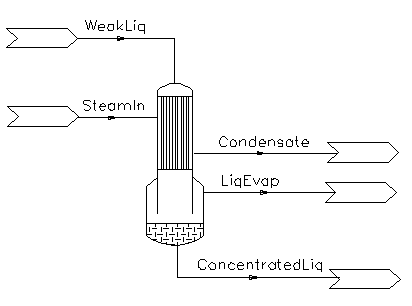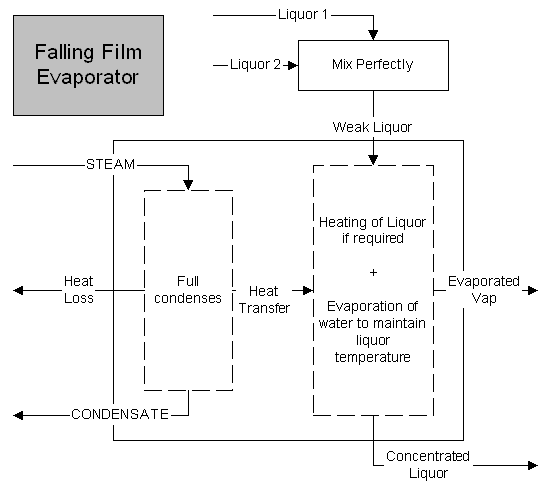Falling Film Evaporator: Difference between revisions
(No difference)
|
Revision as of 09:16, 18 July 2007
Navigation: Main Page -> Models -> Energy Transfer Models
General Description
The falling film evaporator is used for liquor concentration. A schematic of the unit operation and its inlets and outlet are found in the next heading, under Diagram.
In a falling film evaporator, weak liquor is pumped to the top of the unit and distributed to the tubes where it runs down as a film. Steam is entered on the shell side, the condensation of the steam provides energy to heat and if hot enough, evaporate water from the weak liquor, thus concentrating the liquor stream.
When specifying the model requirements, the user has the option to enter in a temperature rise required for the liquor stream, this is for the case when the weak liquor entering is not close to its boiling point, thus heating of the liquor is required. If this temperature rise term is left blank, SysCAD assumes the liquor stream will enter and leave at the same temperature.
The concentrated liquor and Liquor Evap streams will leave the system at Saturated Pressure based on the Final liquor temperature.
On the shell side, a heat loss term can be specified. This accounts for any inefficiency of the unit. If this heat loss term is zero, then all the energy from steam condensation will be used to heat and evaporate the weak liquor. The condensate will leave the system at saturated temperature based on the steam pressure.
NOTE: To avoid any accidental incorrect feed liquor specifications, (thus left at default conditions of 20dC and atmospheric pressure), the model has a minimum pressure which the unit operation must keep to. This field is user configurable and can be used to prevent unrealistic answers from the model.
WARNING: Currently, the Falling Film Evaporator will NOT be included as part of the Flash Train.
Diagram
The diagram shows a drawing of the Falling Film Evaporator, with the required connecting streams. The Falling Film Evaporator expects 2 inlets: Steam In, and Weak Liquor in. Three outlets must also be connected, these are: condensate, concentrated liquor and evaporated vapour from the liquor.
Inputs and Outputs
|
Label |
Input / Output |
No. of Connections |
Description | |
|
|
|
Min |
Max. |
|
|
Steam |
In |
1 |
1 |
The steam inlet to the Shell Side. |
|
Liquor_in |
In |
1 |
10 |
The weak liquor inlet to the tube side. |
|
Condensate |
Out |
1 |
1 |
The condensate on the shell side. |
|
Liquor_out |
Out |
1 |
1 |
The concentrated liquor. |
|
Liquor_Evap |
Out |
1 |
1 |
The evaporated vapour from the liquor. |
|
Shell_Vent |
Out |
0 |
1 |
The un-condensable vent on the shell side. |
Model theory
The amount of evaporated steam from the liquor stream is calculated based on:
1) Energy from fully condensing of steam.
(File:Models-Falling Film Evaporator-image002.gif)
[math]\displaystyle{ \mathbf{\begin{pmatrix}Q = m_{steam}\lambda_{steam}\end{pmatrix}} }[/math]
2) Less heat loss specified by the user
3) Less energy used to heat liquor stream to required temperature.
(File:Models-Falling Film Evaporator-image004.gif)
[math]\displaystyle{ \mathbf{\begin{pmatrix}\int\limits_{T1}^{T2}m_{liquor}CpdT\end{pmatrix}} }[/math]
4) Mass of evaporated steam is = Energy available / latent heat (Final Liquor T, P)
Flowchart
Data Sections
The default access window consists of three sections,
a) The first tab has the same name as the model tag, contains general information relating to the unit.
b) Second tab HX
a) The last tab Audit, fully described in Audit Section. See Model Examples for enthalpy calculation Examples.
First Section- Tag Name
|
Tag / Symbol |
Input / Calc |
Description |
|
| ||
Second Section- HX
|
Requirements | ||
|
On |
Tick Box |
If this option is switched off, then the unit operation will behave like a pipe model. Thus, inlet conditions = outlet conditions and no heat transfer will take place. |
|
Duty |
Calc |
The energy available from the fully condensed steam, less any heat loss specified. |
|
Tube Side (liquor) | ||
|
AllowEvap |
Tick Box |
If this option is switched off, then the unit operation will behave like a Shell and Tube heat exchanger, thus no evaporation of liquor will occur. |
|
TRiseRqd |
Input |
This is the temperature increase required for the liquor stream. It is NOT required if the liquor stream entering is at its saturation conditions. The final temperature of the liquor stream also sets the unit operation pressure, which is at saturation pressure based on the temperature. |
|
MinPOut |
Input |
This is the minimum pressure the unit must keep to. |
|
EvapQm |
Calc |
This is the amount of vapour evaporated from the liquor phase. |
|
Shell Side | ||
|
HeatLoss |
Input |
This is the heat loss on the steam condensing side. Thus the energy available to the tube side is affected by this term. |
|
VapQmOut |
Calc |
This is the amount of non-condensable leaving the shell side. This will leave via the Shell_vent if it is connected. If a vent stream is not connected, but VentExcessShellVap option is on, then the vapour will be vented (disappears) from the unit operation, otherwise the non-condensable will go out with the condensate stream. |
|
VentExcess ShellVap |
Tick Box |
This option will only be available if the Shell_vent is not connected. When this option is on, any non-condensable will be vented, otherwise they will go out with the condensate stream. |
|
TrackSteamFrac |
Input |
This adds a check on the composition of steam feed. |
|
Tag.Tube | ||
|
Qm |
Calc |
The mass flow of Liquor stream |
|
Ti |
Calc |
The weak liquor temperature. |
|
To |
Calc |
The concentrated liquor temperature. |
|
Pi |
Calc |
The weak liquor Pressure. |
|
Po |
Calc |
The concentrated liquor Pressure. |
|
Vfi |
Calc |
The weak liquor vapour fraction. |
|
Vfo |
Calc |
The liquor vapour fraction after evaporation & prior to stream separation. |
|
SatT |
Calc |
The concentrated liquor saturation temperature (at Pressure). |
|
SatP |
Calc |
The concentrated liquor saturation pressure (at temperature). |
|
Tag.Shell | ||
|
Qm |
Calc |
The mass flow of steam |
|
Ti |
Calc |
The inlet steam temperature. |
|
To |
Calc |
The condensate temperature. |
|
Pi |
Calc |
The inlet steam Pressure. |
|
Po |
Calc |
The condensate Pressure. |
|
Vfi |
Calc |
The inlet steam quality (vapour fraction). |
|
Vfo |
Calc |
The vapour fraction of non-condensable. |
|
SatT |
Calc |
The condensate saturation temperature (at Pressure). |
|
SatP |
Calc |
The condensate saturation pressure (at temperature). |
Hints and Comments
1) Currently, the Falling Film Evaporator is NOT included in the groups of models that will form a Flash Train. Therefore, if a Flash tank and Falling film evaporator is placed together, it will NOT automatically demand steam from the flash tank. Thus, the user needs to configure the flash tank as if it is stand-alone, then the steam evaporated can be used to feed the Falling film evaporator.

